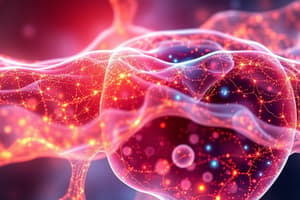Podcast
Questions and Answers
What is the role of unsaturated fatty acids in the structure of cell membranes?
What is the role of unsaturated fatty acids in the structure of cell membranes?
- They stabilize the hydrophobic tails.
- They prevent the formation of kinks.
- They introduce kinks in the hydrophobic tails. (correct)
- They lengthen the phospholipid molecules.
Which statement accurately describes the fluid mosaic model of the plasma membrane?
Which statement accurately describes the fluid mosaic model of the plasma membrane?
- It consists of rigid structures that do not move.
- It is made exclusively of proteins.
- It has only phospholipids and carbohydrates.
- It allows components to flow and change position. (correct)
Which type of protein is permanently embedded in the plasma membrane?
Which type of protein is permanently embedded in the plasma membrane?
- Glycoprotein
- Peripheral protein
- Integral protein (correct)
- Channel protein
What function does a channel protein serve in the cell membrane?
What function does a channel protein serve in the cell membrane?
Which component of the plasma membrane mainly aids in cell recognition?
Which component of the plasma membrane mainly aids in cell recognition?
How does the fluidity of the plasma membrane affect enzyme function?
How does the fluidity of the plasma membrane affect enzyme function?
What characteristic distinguishes peripheral proteins from integral proteins?
What characteristic distinguishes peripheral proteins from integral proteins?
What structural feature of the cell membrane is essential for its fluid nature?
What structural feature of the cell membrane is essential for its fluid nature?
What is the primary role of the sodium-potassium pump in cells?
What is the primary role of the sodium-potassium pump in cells?
Which of the following best describes the mechanism of filtration in the kidneys?
Which of the following best describes the mechanism of filtration in the kidneys?
What is a characteristic of active transport compared to passive transport?
What is a characteristic of active transport compared to passive transport?
How many sodium ions are extruded from the cell in a single cycle of the sodium-potassium pump?
How many sodium ions are extruded from the cell in a single cycle of the sodium-potassium pump?
Which statement about endocytosis is true?
Which statement about endocytosis is true?
Which ion is primarily pumped out of the cell by the sodium-potassium pump?
Which ion is primarily pumped out of the cell by the sodium-potassium pump?
What types of cells are particularly abundant with sodium-potassium pumps?
What types of cells are particularly abundant with sodium-potassium pumps?
What role does ATP play in active transport mechanisms like the sodium-potassium pump?
What role does ATP play in active transport mechanisms like the sodium-potassium pump?
What factor determines the movement of substances across a cell membrane through diffusion?
What factor determines the movement of substances across a cell membrane through diffusion?
Which type of diffusion does not require any assistance from proteins?
Which type of diffusion does not require any assistance from proteins?
Which of the following substances would be likely to cross the lipid bilayer by simple diffusion?
Which of the following substances would be likely to cross the lipid bilayer by simple diffusion?
What is the primary energy source used in active transport across the cell membrane?
What is the primary energy source used in active transport across the cell membrane?
What type of transport mechanism is osmosis classified as?
What type of transport mechanism is osmosis classified as?
In which scenario would a substance diffuse into a cell?
In which scenario would a substance diffuse into a cell?
What is the main role of the hydrophobic tails in the phospholipid bilayer?
What is the main role of the hydrophobic tails in the phospholipid bilayer?
What is the net result of diffusion?
What is the net result of diffusion?
Which solution has a greater concentration of solutes compared to the inside of a cell?
Which solution has a greater concentration of solutes compared to the inside of a cell?
What is the primary effect of a hypotonic solution on red blood cells (RBCs)?
What is the primary effect of a hypotonic solution on red blood cells (RBCs)?
Which type of transport uses a hydrostatic pressure gradient?
Which type of transport uses a hydrostatic pressure gradient?
During osmosis, what must exist for the process to occur effectively?
During osmosis, what must exist for the process to occur effectively?
What typically happens to cells in an isotonic solution?
What typically happens to cells in an isotonic solution?
Which of the following is considered the most hypotonic solution?
Which of the following is considered the most hypotonic solution?
What role do kidneys play in maintaining proper cellular conditions?
What role do kidneys play in maintaining proper cellular conditions?
What occurs in a hypertonic environment for a cell?
What occurs in a hypertonic environment for a cell?
What is the primary role of a vesicle in endocytosis?
What is the primary role of a vesicle in endocytosis?
Which form of endocytosis is specifically used by immune cells to ingest large particles?
Which form of endocytosis is specifically used by immune cells to ingest large particles?
In receptor-mediated endocytosis, what initiates the process?
In receptor-mediated endocytosis, what initiates the process?
What is the primary distinction between phagocytosis and pinocytosis?
What is the primary distinction between phagocytosis and pinocytosis?
What is exocytosis primarily involved in?
What is exocytosis primarily involved in?
Which example illustrates the process of exocytosis?
Which example illustrates the process of exocytosis?
What kind of material do immune cells typically secrete through exocytosis?
What kind of material do immune cells typically secrete through exocytosis?
What defines receptor-mediated endocytosis compared to other forms of endocytosis?
What defines receptor-mediated endocytosis compared to other forms of endocytosis?
Flashcards are hidden until you start studying
Study Notes
Plasma Membrane Structure
- The fluid mosaic model describes the plasma membrane as a constantly shifting, dynamic structure
- The plasma membrane is composed of a phospholipid bilayer with embedded proteins and cholesterol
- The membrane's fluidity allows for the movement of molecules within it
- Unsaturated fatty acids in the phospholipid tails create kinks, increasing fluidity
- Integral proteins are embedded within the membrane permanently
- Channel proteins facilitate the movement of specific ions across the membrane
- Cell recognition proteins identify the cell and allow for communication with other cells
- Receptor proteins are a type of recognition protein that bind to specific molecules, triggering reactions within the cell
- Glycoproteins attached with carbohydrate molecules aid in cell recognition
- Peripheral proteins associate with the membrane, but are not permanently embedded
- Nonpolar substances, like oxygen and carbon dioxide, can easily pass through the lipid bilayer
- Water-soluble materials, such as glucose, require assistance to cross the membrane due to the hydrophobic nature of the tails
- The cell membrane regulates the movement of substances across it through passive or active transport
Passive Transport
- Passive transport moves substances across the membrane without using cellular energy
- It occurs down the concentration gradient - from an area of higher concentration to lower concentration
- Diffusion is the net movement of particles from an area of high concentration to an area of lower concentration
- Simple Diffusion: substances pass directly through the membrane without assistance
- Facilitated Diffusion: substances require the assistance of carrier proteins to move across the membrane
- Osmosis is the diffusion of water through a semipermeable membrane down its concentration gradient
- Hypertonic solutions have a higher solute concentration than the cell, causing water to move out of the cell
- Isotonic solutions have the same solute concentration as the cell, resulting in no net water movement
- Hypotonic solutions have a lower solute concentration than the cell, causing water to move into the cell
- Filtration is a pressure-driven movement of substances, pushing fluid from a high-pressure area to a low-pressure area
Active Transport
- Active transport requires energy (ATP) to move substances across the membrane, often against their concentration gradient
- The sodium-potassium pump uses ATP to move sodium ions out of the cell and potassium ions into the cell
- Endocytosis: the cell engulfs material by surrounding it with a portion of its membrane, forming a vesicle
- Phagocytosis: the cell engulfs large particles, such as bacteria
- Pinocytosis: the cell ingests fluid and dissolved substances
- Receptor-mediated endocytosis is highly specific, where receptors bind to specific molecules, triggering the engulfment of that portion of the membrane
- Exocytosis: the cell releases materials from the inside to the outside using vesicles
Studying That Suits You
Use AI to generate personalized quizzes and flashcards to suit your learning preferences.




